MyDigitalSSD SMART & BP3 mSATA SSD Review
by Kristian Vättö on January 22, 2013 1:24 PM ESTAnandTech Storage Bench 2011
Last year we introduced our AnandTech Storage Bench, a suite of benchmarks that took traces of real OS/application usage and played them back in a repeatable manner. Anand assembled the traces out of frustration with the majority of what we have today in terms of SSD benchmarks.
Although the AnandTech Storage Bench tests did a good job of characterizing SSD performance, they weren't stressful enough. All of the tests performed less than 10GB of reads/writes and typically involved only 4GB of writes specifically. That's not even enough exceed the spare area on most SSDs. Most canned SSD benchmarks don't even come close to writing a single gigabyte of data, but that doesn't mean that simply writing 4GB is acceptable.
Originally we kept the benchmarks short enough that they wouldn't be a burden to run (~30 minutes) but long enough that they were representative of what a power user might do with their system. Later, however, we created what we refer to as the Mother of All SSD Benchmarks (MOASB). Rather than only writing 4GB of data to the drive, this benchmark writes 106.32GB. This represents the load you'd put on a drive after nearly two weeks of constant usage. And it takes a long time to run.
1) The MOASB, officially called AnandTech Storage Bench 2011—Heavy Workload, mainly focuses on the times when your I/O activity is the highest. There is a lot of downloading and application installing that happens during the course of this test. Our thinking was that it's during application installs, file copies, downloading, and multitasking with all of this that you can really notice performance differences between drives.
2) We tried to cover as many bases as possible with the software incorporated into this test. There's a lot of photo editing in Photoshop, HTML editing in Dreamweaver, web browsing, game playing/level loading (Starcraft II and WoW are both a part of the test), as well as general use stuff (application installing, virus scanning). We included a large amount of email downloading, document creation, and editing as well. To top it all off we even use Visual Studio 2008 to build Chromium during the test.
The test has 2,168,893 read operations and 1,783,447 write operations. The IO breakdown is as follows:
| AnandTech Storage Bench 2011—Heavy Workload IO Breakdown | ||||
| IO Size | % of Total | |||
| 4KB | 28% | |||
| 16KB | 10% | |||
| 32KB | 10% | |||
| 64KB | 4% | |||
Only 42% of all operations are sequential; the rest ranges from pseudo to fully random (with most falling in the pseudo-random category). Average queue depth is 4.625 IOs, with 59% of operations taking place in an IO queue of 1.
Many of you have asked for a better way to really characterize performance. Simply looking at IOPS doesn't really say much. As a result we're going to be presenting Storage Bench 2011 data in a slightly different way. We'll have performance represented as Average MB/s, with higher numbers being better. At the same time we'll be reporting how long the SSD was busy while running this test. These disk busy graphs will show you exactly how much time was shaved off by using a faster drive vs. a slower one during the course of this test. Finally, we will also break out performance into reads, writes, and combined. The reason we do this is to help balance out the fact that this test is unusually write intensive, which can often hide the benefits of a drive with good read performance.
There's also a new light workload for 2011. This is a far more reasonable, typical every day use case benchmark. It has lots of web browsing, photo editing (but with a greater focus on photo consumption), video playback, as well as some application installs and gaming. This test isn't nearly as write intensive as the MOASB but it's still multiple times more write intensive than what we were running last year.
We don't believe that these two benchmarks alone are enough to characterize the performance of a drive, but hopefully along with the rest of our tests they will help provide a better idea. The testbed for Storage Bench 2011 has changed as well. We're now using a Sandy Bridge platform with full 6Gbps support for these tests.
AnandTech Storage Bench 2011—Heavy Workload
We'll start out by looking at average data rate throughout our new heavy workload test:
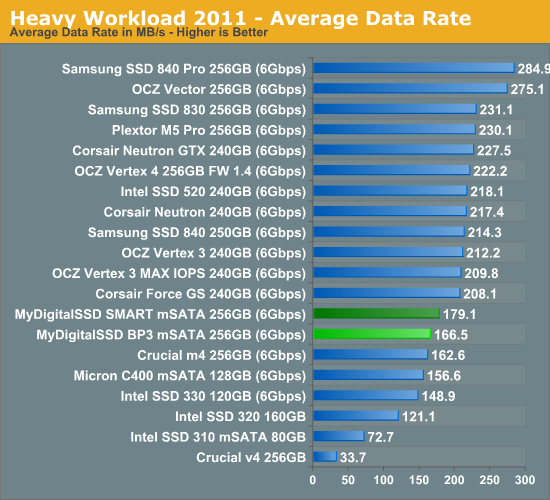
Despite the limitations of the PS3108 controller, the BP3 performs decently. The gap between it and the SandForce based SMART is only 12.6MB/s in our Heavy suite. Neither of the drives is able to keep up with standard 2.5" SSDs, but it's worthwhile to note that some of this is due to the limited NAND bandwidth (4 packages versus 8-16 in 2.5" SSDs).

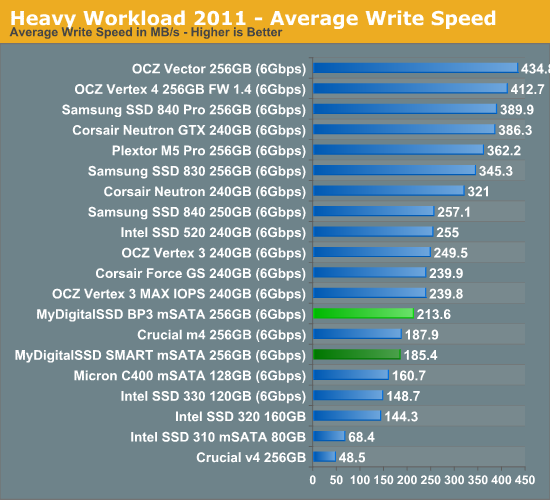
The next three charts just represent the same data, but in a different manner. Instead of looking at average data rate, we're looking at how long the disk was busy for during this entire test. Note that disk busy time excludes any and all idles, this is just how long the SSD was busy doing something:
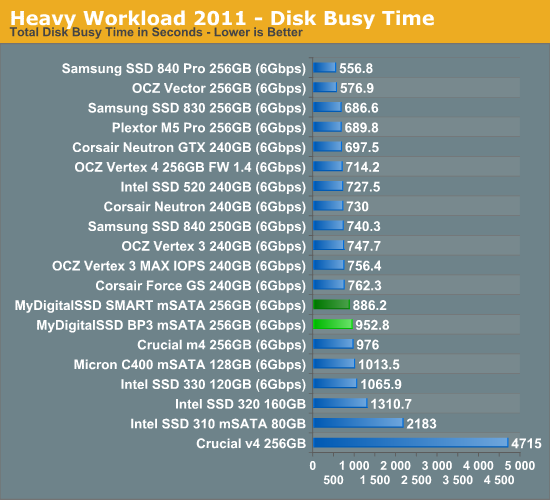
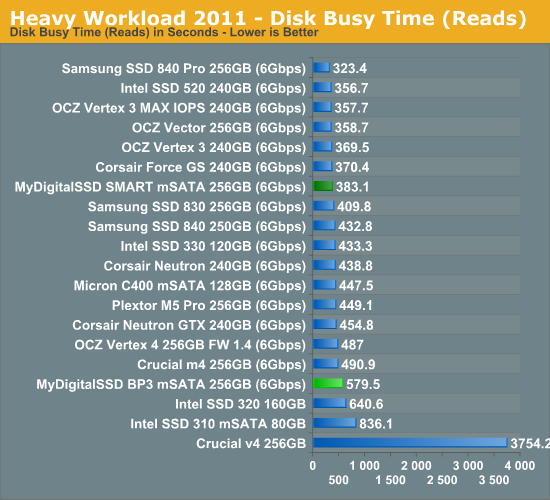
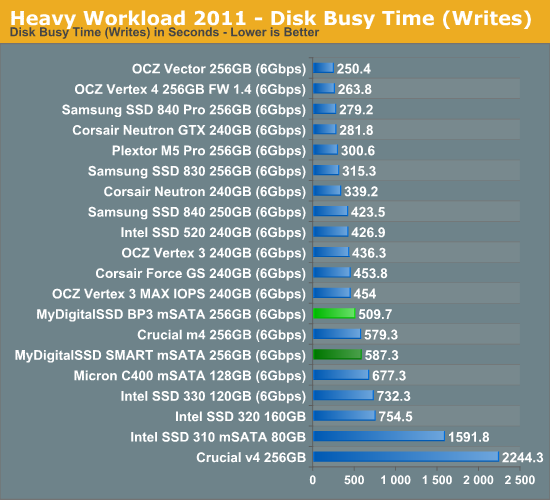










49 Comments
View All Comments
nathanddrews - Friday, January 25, 2013 - link
I have a JMicron-based G.SKILL FM-25S2S-64GB sitting around doing nothing. It has a USB port so I sometimes use it as a thumb drive. I am more than happy to donate it to the cause. Just tell me where to send it.Kristian Vättö - Saturday, January 26, 2013 - link
I bet sending the drive to Finland will cost more than the drive itself ;-) Anand should have some older SSDs, so I'll ask if he could run some testsnathanddrews - Saturday, January 26, 2013 - link
I just checked estimates from FedEx and UPS... You are not kidding! I thought it would cost about $25, not $125.Anand lives in southern USA, doesn't he? That should be very cheap. If he doesn't have one of these kickass drives, I'll send it to him. ;-)
Kristian Vättö - Saturday, January 26, 2013 - link
Anand lives in Raleigh, North Carolina. He still has JMicron based drives (just asked him) and he'll run some tests once he finds one, so no need to send one :-)nathanddrews - Saturday, January 26, 2013 - link
Cool, can't wait to see the results. Thanks, Kristian!Per Hansson - Thursday, January 31, 2013 - link
That's nice Kristian!I'm looking forward to seeing those results :)
Tjalve - Tuesday, April 9, 2013 - link
Ive actually done some testing on performance consistency for my reviews over att Nordichardware.sehttp://www.nordichardware.se/SSD-Recensioner/svens...
Theese tests are NOT done on a steady state drive though. But theese nuymbers give an indication on how I/O Latency are reflected i a real-world situation.
AND the graphs include some crappy drives like the Verbatim SSD 128GB and the Teamgroup L2 128GB.
I actually have steady state 4K Write perormance numbers (similiar to the ones here) on most drives aswell, but i havet published them just yet.
Gunbuster - Tuesday, January 22, 2013 - link
Workstation laptops. Going mSATA for OS often leaves you two other spindles for large spinning storage, another SSD or a combo of both.Why? For Hyper-V devs or content creators.
madmilk - Tuesday, January 22, 2013 - link
Workstation laptops and DIY upgrading is quite a niche scenario. Most workstation owners (that is, businesses) would just build-to-order with the SSD, instead of risking downtime just to save a couple hundred bucks.critical_ - Tuesday, January 22, 2013 - link
I own a Dell M6700 with the ADATA SX300 mSATA SSD (256GB) and 3 Hitachi 7200RPM 2.5" 1TB drives in RAID5. While I'd like to think I'm the only person in the world with this configuration, that would be silliness on my part. :)